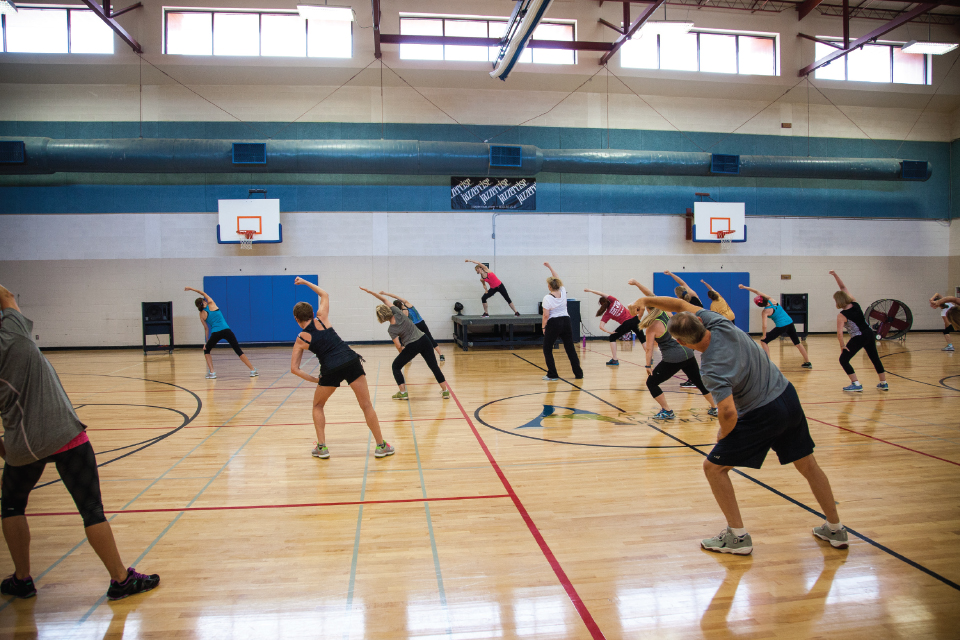Jazzercise vs. Zumba

Jazzercise
I’ve never taught Jazzercise, but I was a student for more than three decades. Created in 1969, Jazzercise has prevailed through changing styles and trends and still manages to be fresh. You have to admire this company’s staying power.
Jazzercise was founded by Judi Sheppard Missett, who turned her love of jazz dance into a worldwide dance exercise phenomenon that offers a fusion of jazz dance, resistance training, Pilates, yoga, and kickboxing movements. The international franchise business hosts a network of 7,800 instructors teaching more than 32,000 classes weekly in 32 countries.
The company also includes a clothing line and home workout DVDs and hosts expos around the world.
Though Jazzercise is offered in a variety of formats, the majority of classes in Austin remain standard Jazzercise, with a warm-up, cardio, and strength training using weights and resistance bands. Classes are designed for all age and fitness levels. Instructor certification is taken seriously, and one benefit is that participants can attend classes in different locations and recognize some of the same routines.
Jazzercise is easy to “get,” in my opinion. The moves are typically in sets, and patterns repeat. Instructors face the class and participants “mirror” their movements.
The music is always in sync with what is popular at the time—including pop, jazz, blues, electronic, Latin, country, and hip hop. With trendy songs as the staple, many a Jazzercise participant will spontaneously break into a routine when a popular song hits the radio. Watch out for curious looks from strangers in nearby cars.
And who doesn’t love to receive Jazzercise catalogs, full of high-quality outfits that can double as part of an active woman’s wardrobe? (Smart move to be able to order items with or without a logo.)
In addition to new choreography throughout the year, Jazzercise utilizes promotions, which are good for creating short-term goals and increasing enthusiasm. Many long-time members are proud of their T-shirt collections.

Zumba
Zumba was created in the 1990s by Alberto (Beto) Perez, a dancer/choreographer from Columbia, and approximately 14 million individuals take classes weekly in 185 countries around the globe.
Classes feature dance and aerobic elements—and the Latin and international music is infectious. Key styles include merengue, salsa, reggaeton, cumbia, samba, hip hop, and more.
Zumba definitely has an international angle. I'm an instructor of a Zumba PE class for City of Austin employees; every other month, I receive a DVD and CD. The demos feature men and women from all around the globe, as well as from the U.S.
Perez relocated to Miami, then to New York—and as they say—the rest is history. One day I realized that Zumba was suddenly everywhere.
Though Zumba is a little less structured than Jazzercise, warm-up and cool-down periods are standard. There is no floor work, and being able to move your hips is a definite plus. Classes are designed for all age and fitness levels.
What happens in the class depends a great deal on the preferences of the instructor. Zumba-trained instructors are free to use songs and choreography provided monthly through the ZIN network, but they are also free to use songs of their choice, making Zumba a bit more free-wheeling.
Now a regular offering at local gyms, Zumba is also found in neighborhood centers and other locations about town. Other class formats include Aqua Zumba, Zumba Step, Zumbini, and Zumba Gold for seniors. Non-verbal cueing is recommended, but many instructors use verbal cueing liberally as well.
Zumba encourages its instructors to support worthy causes, and community "Zumbathons" are the fun and worthwhile result. Zumba clothing definitely has an edgy vibe, with colors and styles that are urban, ethnic, comfortable, and fun.
What’s the Verdict?
In the end, Jazzercise and Zumba have a lot in common. Both emphasize having fun while moving (“exercise in disguise”), and both are welcoming to new participants. Both typically offer a one-hour class at a set location, encouraging ongoing attendance—and the cost per class is roughly equivalent.
Friendships develop with classmates and the instructor. The social aspect is appreciated by all, keeping participants engaged and coming back. Your particular experience will depend to some extent on the personality and skills of the instructor and the setting you choose.
Jazzercise or Zumba—either is a good choice. What’s not to like about getting a good workout, enjoying an upbeat vibe, and bonding with others who are doing the same?






